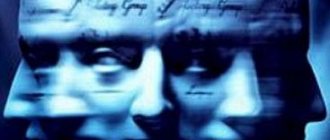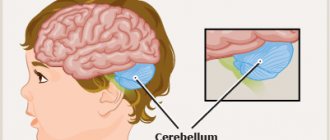Discirculatory encephalopathy 1, 2, 3 degrees, brain treatment, ICD-10
Disturbances in blood circulation in the vessels of the brain have very serious consequences. One of the diseases leading to this is discirculatory encephalopathy. When diagnosing it, it is imperative to carry out qualified treatment in order to avoid the disease progressing to a more severe degree, which often results in disability.
What it is?
Discirculatory encephalopathy is a disease in which, due to impaired blood supply, the brain does not function properly.
The pathology is also characteristic of the cortex and subcortical regions of the brain; it requires mandatory treatment , which is prescribed based on the degree of the disease.
The main symptoms are damage to motor and psychophysical function, which affects the general condition of the person, who, among other things, becomes susceptible to frequent emotional disorders.
The main cause of the disease is an imbalance in the supply of oxygen carried by the blood into the vessels, since cerebral circulation is disrupted due to various factors.
As a result, various lobes of the brain are in a state of oxygen starvation and do not receive vital substances. Subsequently, dyscirculatory encephalopathy constantly progresses, which gradually leads to the death of the brain areas susceptible to pathology.
In such an area, a rarefaction center is formed, which is small in size; its localization can vary significantly.
At the initial stage, discirculatory encephalopathy occurs with active resistance of the body, when it, at the expense of healthy cells, tries in every possible way to replace the functionality of dead ones.
However, if treatment measures are not taken further, the disease becomes more severe, and the replacement cells themselves begin to experience oxygen starvation.
Often, due to defective brain activity, the result of the pathological process is disability of varying degrees.
The early stage of dyscirculatory encephalopathy, which occurs without pronounced symptoms and signs, can last quite a long time, sometimes it lasts several years.
Causes
The disease of discirculatory encephalopathy does not happen out of the blue, there is always some initiator due to which the development of the disease begins, most often it is:
- Atherosclerosis
- Vegetovascular dystonia
- Existence of traumatic brain or spinal cord injuries
- Hypertonic disease
- Diabetes
- Improper functioning of the vertebral vessels
- Excessive blood viscosity and other pathologies
- High cholesterol
- Prolonged stress and depression
- Over or underweight
- Physical inactivity and inactivity
- Bad habits
Kinds
Discirculatory encephalopathy in medicine is divided according to several criteria. The first classification is by origin , based on this, the disease is:
- Atherosclerotic
- Hypertensive
- Venous
- Mixed
According to the speed of development, there is a division into slow , when the transition from stages 1 to 2 or from stages 2 to 3 occurs over several years (4-5). In this case, remission and exacerbation of the pathology are often observed. The next one is rapid , when progression from the first to the last degree occurs in just a couple of years.
Based on the consequences of encephalopathy for the patient’s health, it is divided into degrees :
- The first is the degree at which only slight deviations in the way the brain functions are noticeable.
- The second degree is characterized by increased symptoms, they become noticeable, but do not have a noticeable effect on the quality of life and ability to work.
- At the third stage of development, the patient is assigned a disability, which will depend on the depth of physical and mental disabilities.
Symptoms
Let us describe the main manifestations and signs that dyscirculatory encephalopathy of various degrees will have.
First
- A person’s emotional background changes, his mood is increasingly bad, there is general depression and rapid irritability.
- Periodically severe headache
- Difficulty concentrating on anything
- Intellectual ability regresses, especially with regard to memory, which is why facts from the past are confused. A phenomenon often arises when information from many years ago is remembered well, but fresh information is not retained in the head at all.
- During active movements, nausea may occur due to dizziness.
- Poor sleep with nightmares and anxiety
Second
With dyscirculatory encephalopathy of the second degree, there is a general worsening of the symptoms of the disease described above, as well as some new symptoms:
- Incessant pain in the head
- Serious memory difficulties
- Difficulty swallowing and speech disturbances are common
- There is noise in the ears, for this reason the patient begins to hear worse
- Yeast attacks of hands, head
- Cramps that periodically spread to the entire body
- Bright flashes of light in the eyes
At this stage, the manifestations of the disease already make adjustments to the normal course of the patient’s life, as a result of which its quality decreases and the ability to work suffers. Often, even this development of encephalopathy leads to the appointment of a 2nd or 3rd disability group.
Third
- Difficulty with orientation in space and time
- Severe disorders of the sensory organs, in which hearing, vision, touch, and coordination of movements can be severely impaired
- Apathy towards everything around you
- Lack of control over feces and urine excretion
- Convulsions
- Insomnia
- In some cases, complete immobility is observed
This set of symptoms of discirculatory encephalopathy leads to the inability to normally perform work duties and even care for oneself, which is why the patient is assigned the first or second degree of disability .
Diagnostics
It is very important that discirculatory encephalopathy is diagnosed as early as possible in order to begin treatment on time and prevent the serious manifestations described in the previous section. An accurate diagnosis requires examination by specialists in various fields of medicine:
- Neurologist
- Ophthalmologist
- Cardiologist
- Endocrinologist
Based on the results of the examination and medical history, various examinations are prescribed to help determine the presence of encephalopathy and its degree, usually these are:
- Ophthalmoscopy
- Electroencephalography
- Ultrasound examination of the vessels of the head and neck
- Checking the patency of the cerebral arteries
- MRI
Additionally, a biochemical and general blood test is performed, checking for elevated sugar and cholesterol levels.
Treatment
How to treat such a complex and diverse disease? Considering the multiplicity of manifestations, as well as based on the causes of dyscirculatory disorder, a complex of procedures is used in treatment. Typically therapy is carried out:
- Special medications , with the help of which it is possible to control blood pressure, keeping it normal, and improve metabolic processes in the body. In addition, medications are used for treatment, the task of which is to improve nutrition of the brain by activating its blood supply.
- Physiotherapeutic procedures , including the use of laser therapy, therapeutic electrosleep, special oxygen and radon baths, massages, acupuncture, hirudotherapy.
Timely, targeted treatment can significantly slow down the development of the initial stages.
If one of the causes of the disease is high cholesterol, it is very important to change your diet to limit the intake of this substance.
Surgery is not used as a method of treating discirculatory encephalopathy, so if the disease is in an advanced form, then most likely you will have to come to terms with it, and with the help of therapy you can only limit further progression.
ethnoscience
In addition, with the permission of the doctor, treatment is often supplemented with traditional methods and methods. Usually it consists of ingesting tinctures of:
- Clover
- hawthorn
- Leaves of strawberry, oregano, birch
- Chamomile with valerian and lemon
- Hops with motherwort and mint
Preventive measures
Prevention consists of constant monitoring of those factors and diseases that lead to encephalopathy due to impaired blood circulation in the brain. For this it is important:
- Check your blood pressure periodically
- Know your blood sugar and cholesterol levels, and if the levels are elevated, then take the necessary actions
- To refuse from bad habits
- Get involved in a light sport
- Watch your weight
- Attend regular clinical examinations
Source: https://MedTelo.ru/med/distsirkulyatornaya-entsefalopatiya-1-2-3-stepeni-lechenie-mozga-mkb-10.html
Frequently ill child - how to change the situation
Many parents are concerned about the question: why does the child often get sick and what to do?
Today in pediatrics there are negative trends and an increase in the incidence of viral respiratory infections and colds in children, including young children.
At the same time, their frequency, duration and risk of a complicated course with the development of:
- otitis media;
- sinusitis;
- adenoiditis and adenoid vegetations;
- bronchitis;
- laryngotracheitis and laryngitis.
In addition, with each episode of illness, both acute respiratory viral infections and acute respiratory infections, the tension of the baby’s immune system gradually decreases, and the following diseases are more difficult to tolerate or take longer to tolerate.
Options with recurrence (repetition) of the infectious-inflammatory process or its repetition in another place are becoming more frequent (starts with rhinitis or tonsillitis, and after a week it repeats in the form of laryngitis or tracheitis).
Therefore, parents need to know what “CHD” is and how to properly deal with it.
Coding of discirculatory encephalopathy in the ICD
Such a dangerous pathology as dyscirculatory encephalopathy according to ICD 10 has the code “I 67”. This disease belongs to the category of cerebrovascular diseases - a general group of pathological conditions of the brain that are formed as a result of pathological transformations of cerebral vessels and disorders of normal blood circulation.
Features of terminology and encoding
The term "encephalopathy" refers to organic disorders of the brain due to necrosis of nerve cells. Encephalopathy in ICD 10 does not have a special code, since this concept unites a whole group of pathologies of various etiologies.
In the International Classification of Diseases, tenth revision (2007), encephalopathies are divided into several headings - “Other cerebrovascular diseases” (heading code “I - 67”) from the class of diseases of the circulatory system and “Other brain lesions” (heading code “G - 93” ) from the class of diseases of the nervous system.
Etiological causes of cerebrovascular disorders
The etiology of encephalopathic disorders is very diverse and different factors can cause different types of pathologies. The most common etiological factors are:
- Traumatic brain damage (severe blows, concussions, bruises) causes a chronic or post-traumatic version of the disease.
- Congenital malformations that may occur due to a pathological pregnancy, complicated childbirth, or as a consequence of a genetic defect.
- Chronic hypertension (high blood pressure).
- Atherosclerosis.
- Inflammatory vascular diseases, thrombosis, dyscirculation.
- Chronic poisoning with heavy metals, drugs, toxic substances, alcohol, drug use.
- Venous insufficiency.
- Excessive radiation exposure.
- Endocrine pathologies.
- Ischemic conditions of the brain and vegetative-vascular dystonia.
Classification of cerebrovascular diseases according to ICD 10
According to the ICD, the encephalopathy code can be encrypted under the letter “I” or “G”, depending on the prevailing symptoms and etiology of the disorder. Thus, if the cause of the development of pathology is vascular disorders, when making a clinical diagnosis, the code “I - 67” - “Other cerebrovascular diseases” is used, which includes the following subsections:
- Dissection of the cerebral arteries (CB) without the presence of their ruptures (“I – 0”).
- Aneurysm of cerebral vessels without their rupture (“I – 1”).
- Cerebral atherosclerosis (“I – 2”).
- Vascular leukoencephalopathy (progressive) (“I – 3”).
- Hypertensive damage to the brain (“I – 4”).
- Moyamoya disease (“I – 5”).
- Thrombosis of the intracranial venous system is non-purulent (“I – 6”).
- Cerebral arteritis (not classified elsewhere) (“I – 7”).
- Other specified vascular lesions of the brain (“I – 8”).
- Unspecified cerebrovascular disease (“I – 9”).
In ICD 10, discirculatory encephalopathy does not have a special code, it is a progressive disease that arises due to vascular dysfunctions, it belongs to the headings “I – 65” and “I – 66”, as it is encrypted with additional codes that clarify the etiology, symptoms or absence thereof.
Classification of encephalopathic lesions of a neurogenic nature and unspecified etiology
If encephalopathy is a consequence of dysfunction of the nervous system, then the pathology is classified under the heading “G - 92” (Toxic encephalopathy) and “G - 93” (Other brain lesions). The last category includes the following subsections:
- Anoxic lesion of the brain, which is not classified in other sections (“G – 93.1”).
- Encephalopathy, unspecified (“G – 93.4”).
- GM compression (“G – 93.5”).
- Reye's syndrome (“G – 93.7”).
- Other specified lesions of the brain (“G – 93.8”).
- GM violation, unspecified (“G – 93.9”).
Clinical symptoms
Manifestations of pathology may be different, depending on the etiology and type, but there are a number of symptoms that are necessarily present in the presence of a cerebrovascular disorder: intense headaches, frequent dizziness, memory disorders, disturbances of consciousness (apathy, persistent depression, desire to die), absent-mindedness and irritability, insomnia. Indifference to others, lack of interests, and difficulty in communication are also noted. Depending on the etiology, emotional disorders, dyspeptic disorders (nausea, vomiting, stool disorders), jaundice, pain in the extremities, obvious weight loss up to cachexia, signs of metabolic disorders (rashes, changes in the skin, swelling) may also be observed.
Source: https://mkbkody.ru/333-distsirkulyatornaya-entsefalopatiya.html
What is ChDB - a modern view of the problem
Many parents are frightened by the definition of BDS, so it is necessary to clarify what this condition means and how to change the situation.
FCH or a frequently ill child is a special group of dispensary observation that has certain criteria:
- frequency of occurrence;
- duration of colds and respiratory viral infections during the year.
Today, experts do not have a consensus on the definition of the so-called “frequently ill child” syndrome, but the main criteria by which the groups FCH (frequently ill children) or FSD (frequently and long-term ill children) are identified are specified:
- child's age;
- frequency and duration of acute respiratory viral infections and acute respiratory infections;
- absence of specified chronic diseases (rhinitis, tonsillitis, sinusitis, bronchitis, adenoiditis).
The pediatrician must register the baby in the CCH group if he has suffered from colds or viral infections during the year:
| Child's age | Frequency and duration of diseases |
| Children of the first year of life | from 4 times a year or 2-3 times a year for more than 14 days |
| From one to three years | 6 times or more or 2-3 times a year from 14 to 20 days |
| From 3 to 5 years | 5 times or more or 2-3 times a year from 14 to 20 days |
| Children over 5 years old | 4 or more times during the year or 2-3 times a year from 14 to 20 days |
ICD code 10 dyscirculatory encephalopathy 1,2,3, degrees in adults
Dyscirculatory encephalopathy (DEP) is a brain disease characterized by circulatory insufficiency in the vessels of the brain, which leads to changes in brain functions.
Doctors are interested in the disease code dyscirculatory encephalopathy in ICD 10. However, this term is not included in the International Classification of Diseases, ninth and tenth revisions.
How to mark this disease in documents, what guides doctors?
ICD 10: cerebrovascular diseases download / open >>
Discirculatory encephalopathy, a slowly progressive multifocal or diffuse vascular lesion of the brain, leads to impaired cognitive functions, paresis and paralysis, pseudobulbar, autonomic and cerebellar disorders, urinary and fecal incontinence.
The main thing in the article
- ICD 10 code
- DEP in adults
- Treatment methods
What is dyscirculatory encephalopathy of the brain?
The diagnosis of DEP indicates damage to cranial structures against the background of negative changes in blood circulation, characterized by slow progress. The main manifestation of the disease is the simultaneous presence of behavioral deviations and motor and emotional disorders. The severity of the listed processes determines the current stage of the pathology.
Due to the slowdown in blood flow, hypoxia, which is unacceptable for brain structures, develops, and local nutrition noticeably deteriorates. The result of these changes is cell death, the formation of areas of leukoaraiosis with sparse brain tissue. Numerous small atrophied foci are also formed, which in the medical environment are called “silent” heart attacks.
As a result of pathological changes, the white matter located in the deep zones suffers the most.
Chronic ischemia causes the phenomenon of “uncoupling,” characterized by improper interaction between the subcortical ganglia and the cerebral cortex.
The consequences of the neglected negative mechanism are the initial development of functional dissonances, which, if untreated, lead to a stable neurological defect and a statement of disability.
Stages of the disease
The initial stage of the pathology is practically asymptomatic and is not diagnosed. The general genesis of the disease is typical for both infants and adults:
- Compensatory stage - alternative oxidation processes in brain cells are inactivated and succinate oxidation without the participation of oxygen is activated, but such compensation is not enough for a long time, and the next stage begins.
- Decompensation is hypoxic suppression of the functioning of nerve receptors. The body's compensatory systems wear out and, due to oxygen starvation, the first noticeable symptoms of the disease begin to appear.
- Terminal stage - death of brain cells occurs, which can cause death.
Diagnostic measures
They are based on a very careful collection of anamnestic data that may indicate the presence of a TBI in the past. Post-traumatic encephalopathy is confirmed by CT or MRI.
During these studies, the specialist receives detailed information about diffuse or focal changes in the brain matter. At the same time, differentiated diagnostics are carried out to exclude other pathologies of the central nervous system, which are accompanied by similar symptoms.
Electroencephalography can be used as an additional study. It allows you to identify the localization of the pathological focus of epileptic activity.
Source: https://neuro-orto.ru/bolezni/encefalopatiya/dep-mkb-10.html
Causes of frequent colds and viral infections in children
An irrefutable fact is that colds and viral infections are becoming more frequent in children compared to adult patients, and this trend is increasing every year.
The causes of NHI can be divided into external and internal factors.
Internal predisposing and provoking factors include:
- immaturity and instability of the immunological reactivity of children under six years of age;
- weak local immunity;
- predisposition to allergic reactions;
- pathological course of pregnancy with intrauterine hypoxia and intoxication;
- undiagnosed dysbacteriosis.
External agents that, when combined with internal factors, increase the risk of developing BDS syndrome:
- uncomfortable microclimate;
- lack of normal sanitary conditions or enhanced sterility;
- contact with a large number of people;
- early colds and viral infections suffered in infancy;
- uncontrolled use of medications;
- bad ecology;
- frequent changes in time or climate zones;
- lack of fresh air flow, hardening, increased wrapping of the child.
In most cases, for a child to develop frequent colds and respiratory infections, a combination of one or two external or internal factors is sufficient, which significantly weaken the general and local immunological reactivity of the body.
Additional provoking agents are:
- starting kindergarten;
- psychological stress;
- untreated infections;
- metabolic disorders that occur due to poor nutrition or internal disorders under the influence of internal factors;
- frequent use of medications.
Characteristics of the disease discirculatory encephalopathy and what is its ICD 10 code?
Discirculatory encephalopathy, the ICD-10 code of which is in the heading I60-I69 “Cerebrovascular diseases”, is a disease characterized by gradually increasing organic changes in brain tissue caused by insufficient blood supply resulting from vascular pathology of various etiologies. Since the international classification does not include a diagnosis of “dyscirculatory encephalopathy,” it is also coded with additional codes that clarify the cause, the presence of certain symptoms, or as asymptomatic (I65-I66).
Mechanism of disease formation
For various reasons (except injuries), the vessels of the brain stop supplying its tissues with oxygen and nutrients. The tissues gradually degrade, and areas of dying tissue form in the brain. They may appear as small diffuse changes or lesions located in the white matter of the brain.
At the onset of the disease, adjacent areas of healthy tissue perform the functions of the affected tissue. But gradually the processes of nerve cells lose their protective myelin sheath, and signals stop reaching neighboring areas of the brain.
Impaired cerebral circulation leads to tissue swelling, expansion of intercellular spaces, cystic formations, persistent expansion of the lumen of a blood vessel or the space surrounding the vessel.
[]J5vRoej4F9s[/]
As a result of disruption of the structure of the epithelial membrane lining the ventricles of the brain, fluid begins to accumulate in the tissues. Large lesions are located in the terminal sections of large and small arteries. With unstable pressure in them and pathology of the vessel walls, a heart attack or the formation of a small cavity in the brain tissue (lacunar infarction) may occur.
Violation of blood outflow occurs when the veins of the brain are compressed by tumors and fluid accumulation.
In any case, an area of the brain is damaged and cannot be restored. A permanent loss of mental, cognitive, motor, sensory and emotional-volitional functions occurs, depending on the location of the pathology.
Since ICD-10 does not contain the term “dyscirculatory encephalopathy,” the description of the disease fits under the headings of the class “Other cerebrovascular diseases”:
- Code I67.3 – “progressive vascular leukoencephalopathy” (CADASIL syndrome, Binswanger disease) – progressive pathologies of the white medulla as a result of arterial hypertension and amyloid angiopathy.
- Code I67.4 – “hypertensive encephalopathy” – a syndrome of cerebrovascular accident resulting from high blood pressure.
- Code I67.8 – “chronic cerebral ischemia” – progressive brain dysfunction as a result of impaired blood supply.
Causes of the disease
The discirculatory form of encephalopathy develops due to the gradual narrowing of the internal space of the arteries. The cause of this pathology can be, according to the definition of ICD-10:
- vascular atherosclerosis - deposition on the walls of blood vessels of cholesterol plaques formed as a result of impaired fat metabolism;
- sudden increase in pressure - as a result of a disturbance in the transmission of impulses, some arteries do not contract in response to increased pressure, and some of the blood “sweats” through the walls of the vessels into the surrounding tissues; diseases lead to such an increase in blood pressure: hypertension, kidney and adrenal diseases;
- diseases or injuries of the cervical spine;
- decreased blood pressure (hypotension);
- inflammation of blood vessels;
- cardiac arrhythmias - insufficient blood flow is created for normal blood supply;
- diabetes mellitus, which leads to pathological changes in blood vessels;
- gene pathologies of blood vessels;
- pathology of blood clotting;
- rheumatism;
- irradiation;
- toxic effects of poisons, alcohol, drugs;
- tumors, etc.
In addition, the occurrence of the disease is facilitated by birth injuries leading to hypoxia, compression of the brain, pathological childbirth, infections during the prenatal period, prematurity and underdevelopment of the fetus.
Classification of pathology
Depending on the cause of the pathology, encephalopathy is divided into the following types:
- hypertensive;
- venous;
- atherosclerotic;
- mixed (usually atherosclerotic + hypertensive);
- alcoholic;
- post-traumatic;
- perinatal.
According to the nature of the course, DEP is divided into the following types:
- slowly progressive;
- with alternating periods of exacerbation and remission (remitting).
Symptomatic manifestations
Each part of the brain is responsible for its own function; when pathological changes occur in the tissues of one or another part of the brain, changes are observed:
- personal (irritability, aggressiveness, mania, etc.);
- verbal (understanding and reproduction of speech);
- mental (memory, logic);
- signal (hearing, vision, touch, smell);
- vestibular (balance, coordination, maintaining a vertical body position);
- pain in different parts of the head;
- sleep disorders (insomnia, drowsiness);
- vegetative (nausea, vomiting, impaired salivation and sweating, increased muscle tone, tremor);
- astheno-neurotic (tearfulness, emotional instability);
- cognitive (concentration, time to process incoming information);
- sexual (sexual dysfunction).
Depending on the increasing severity of the disease and the severity of the symptom complex, discirculatory type encephalopathy is divided into three stages:
- moderate stage of DE;
- pronounced stage of DE;
- pronounced stage of DE.
Establishing diagnosis
The exact diagnosis of the disease, its stage, progression and functional impairments are determined based on measures such as:
- examination of specialists: neurologist, nephrologist, cardiologist, phlebologist, angiologist, ophthalmologist;
- hardware studies: ultrasound, tomography, ultrasound of head and neck vessels, ECG, angiography, blood pressure monitoring;
- laboratory tests: coagulogram, lipidogram, determination of blood hematocrit, blood sugar, bacterial culture, autoantibodies.
Based on the analysis of specialists’ conclusions about various dysfunctions, the exclusion of diseases with a similar symptom complex, and laboratory tests, treatment is prescribed.
Diagnostics
Diagnosis of residual encephalopathy is a complex process that includes many laboratory and instrumental techniques for examining a small patient.
In the early stages of the development of pathology, its symptoms can develop in a latent form.
The only way to detect the disease is a comprehensive examination of the child’s brain.
The following procedures are used for diagnosis:
- electroencephalography;
- MRI of the brain;
- CT scan of the brain and internal organs;
- general blood and urine analysis;
- nuclear magnetic resonance;
- Doppler ultrasound;
- biochemical analysis of blood and urine;
- cerebrospinal fluid puncture.












